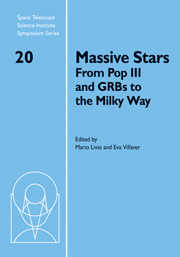Book contents
- Frontmatter
- Contents
- Participants
- Preface
- High-mass star formation by gravitational collapse of massive cores
- Observations of massive-star formation
- Massive-star formation in the Galactic center
- An x-ray tour of massive-star-forming regions with Chandra
- Massive stars: Feedback effects in the local universe
- The initial mass function in clusters
- Massive stars and star clusters in the Antennae galaxies
- On the binarity of Eta Carinae
- Parameters and winds of hot massive stars
- Unraveling the Galaxy to find the first stars
- Optically observable zero-age main-sequence O stars
- Metallicity-dependent Wolf-Rayet winds
- Eruptive mass loss in very massive stars and Population III stars
- From progenitor to afterlife
- Pair-production supernovae: Theory and observation
- Cosmic infrared background and Population III: An overview
From progenitor to afterlife
Published online by Cambridge University Press: 04 August 2010
- Frontmatter
- Contents
- Participants
- Preface
- High-mass star formation by gravitational collapse of massive cores
- Observations of massive-star formation
- Massive-star formation in the Galactic center
- An x-ray tour of massive-star-forming regions with Chandra
- Massive stars: Feedback effects in the local universe
- The initial mass function in clusters
- Massive stars and star clusters in the Antennae galaxies
- On the binarity of Eta Carinae
- Parameters and winds of hot massive stars
- Unraveling the Galaxy to find the first stars
- Optically observable zero-age main-sequence O stars
- Metallicity-dependent Wolf-Rayet winds
- Eruptive mass loss in very massive stars and Population III stars
- From progenitor to afterlife
- Pair-production supernovae: Theory and observation
- Cosmic infrared background and Population III: An overview
Summary
The sequence of massive-star supernova types IIP (plateau light curve), IIL (linear light curve), IIb, IIn (narrow line), Ib, and Ic roughly represents a sequence of increasing mass loss during the stellar evolution. The mass loss affects the velocity distribution of the ejecta composition; in particular, only the IIP's typically end up with H moving at low velocity. Radio and x-ray observations of extragalactic supernovae show varying mass-loss properties that are in line with expectations for the progenitor stars. For young supernova remnants, pulsar wind nebulae and circumstellar interaction provide probes of the inner ejecta and higher velocity ejecta, respectively. Among the young remnants, there is evidence for supernovae over a range of types, including those that exploded with much of the H envelope present (Crab Nebula, 3C 58, 0540–69) and those that exploded after having lost most of their H envelope (Cas A, G292.0+1.8).
Introduction: Core-collapse supernovae
Core-collapse supernovae show considerable diversity among their properties. A basic observational division is into the SNe II (Type II supernovae), which have hydrogen in their spectra, and SNe Ib/c, which do not (or have weak hydrogen lines). The reason for the difference is that the progenitors of the SN Ib/c have lost their H envelopes, and perhaps more, during their evolution leading up to the supernova.
- Type
- Chapter
- Information
- Massive StarsFrom Pop III and GRBs to the Milky Way, pp. 199 - 208Publisher: Cambridge University PressPrint publication year: 2009
- 2
- Cited by



